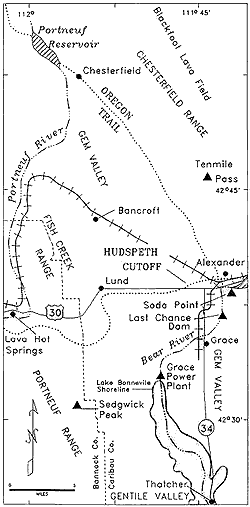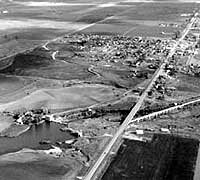|
Page
86
|

|
||
 |
||
| Map of the Gem Valley area. Click on image for a larger view. |
Gem
Valley and Gentile Valley
The first
settlers of the area between the Portneuf and Bear River Ranges(Gem Valley)
were non-Mormons (Gentiles) who homesteaded in the southern end of the valley
in the 1860s. The west side of the Bear River became known as Gentile Valley
by 1875. The first three Mormon families settled in 1871 with impetus from Brigham
Young, who was planning on the Utah-Northern Railroad Company coming through
the southern end of the valley on the way to Soda Springs.
|
Oscar Sonnenkalb wrote, concerning Gentile Valley in the 1880s, that:
|
City
of Grace
The first
bridge across Bear River north of the present site of Grace was built in 1893,
and the city was established shortly thereafter. Farming on the surrounding
country was dependent upon irrigation efforts of the Last Chance Canal Company,
which proceeded slowly and with great effort.In 1913, the Oregon Short Line
completed the Grace Branch Line. In 1915,the village of Grace was incorporated.
The village was named after the wife of the land agent in Blackfoot.
 |
| Aerial view looking south at Grace, (May, 1992). The Utah Power and Light Company dam is in the left foreground, with the flume on an elevated trestle crossing under the highway to the right. Bear River occupies canyon cut in Pleistocene basalt. The East Branch of the Last Chance Canal winds east of town in the center left of the view. |
Last
Chance Canal
Attempts
to get water to the Grace area were unsuccessful between 1895and 1902. Although
the Bear River ran just to the north, it was deep in a basalt canyon, and the
water was inaccessible. Furthermore, Gem Valley's winters were harsh, and wooden
flumes for canals using water from Bear River were repeatedly destroyed by winter
snows. On March 4, 1897 the Last Chance Irrigation Co. filed for Bear River
water and a dam site was selected a mile and half below Soda Point (Sheep Rock).
Construction started in1898. The canal was opened in 1902-1904 and today provides
water for farmland both north and south of Bear River on the upland around Grace.
The Last Chance Canal was built without federal assistance and without outside capital by local farmers, who worked cooperatively in the best spirit of the Mormon settlers. To provide footings for the dam, the farmers built log cribs of timber and rocks which they set on the ice-covered river in the winter. They hauled huge timbers 60 feet in length.
|
Fred Cooper who served as secretary of the Last Chance Canal Co. from1928 to 1961 said:
|